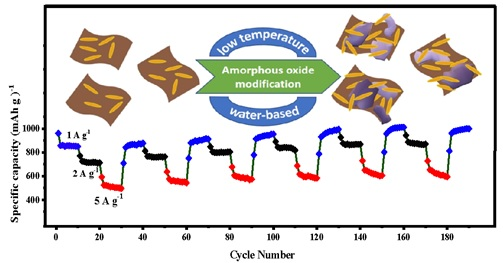With the growing global demand for energy and the alarming environmental repercussions of the continued usage of fossil fuels, the development of clean and efficient energy storage devices has become the need of the hour. Lithium-ion batteries (LIBs), with their high energy density, have become one of the most reliable energy storage devices with a host of diverse applications ranging from powering portable electronics to fuelling hybrid electric vehicles. Further, the requirements for the next-generation LIBs are now focused towards improving the safety, capacity, stability, and charging speed of the batteries.
A team at the Centre for Nano and Soft Matter Sciences (CeNS), an autonomous institute of the Department of Science and Technology (DST), led by Dr. H. S. S. Ramakrishna Matte, have developed a high-capacity anode that is extremely stable at high rates. The anode is a ternary FeOOH-rGO-MnO2 composite anode synthesised by a simple low-temperature synthetic procedure.
The work, which is published in ACS Applied Energy Materials, showcases the stable cycling performance of the anode at high rates, wherein it delivered capacities of 956, 842, and 688 mAh g-1 (milliampere-hours per gram mass- unit of specific capacity) at 1, 2, and 5 A g-1 respectively for 200 cycles along with cycling stability of 900 mAh g-1 at 1 A g-1 for 100 cycles. Various electrochemical techniques were used to analyse the superior performance of the ternary composite anode. It was deduced that the carbon matrix effectively provides favourable pathways for electron conduction and aids in the stable solid electrolyte interface (SEI) formation. The amorphous MnO2, on the other hand, maintains the structural integrity of the electrode by controlling volume expansion, which is a major challenge faced by conversion-based anode materials. Further, the exceptional stability of the anode at high rates was attributed to the increased pseudocapacitive nature in the FeOOH-rGO-MnO2 ternary composite anode, due to the presence of amorphous MnO2, paving the way for faster electrode kinetics.
Thus, the simple and versatile amorphous-MnO2 modification strategy employed to optimize the FeOOH anode in this work could be extrapolated to other conversion-based materials to address similar problems and achieve their maximum capabilities. A patent has also been filed based on this work which could be a potential alternative to the commercial graphite anode in LIBs.
Publication details: DOI: https://doi.org/10.1021/acsaem.2c03953
For further details, Dr. H S S Ramakrishna Matte (Email: matte[at]cens[dot]res[dot]in) can be contacted.

Figure. High-rate capability and long-term cycling of the FeOOH-rGO-MnO2 ternary composite anode






























